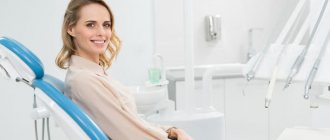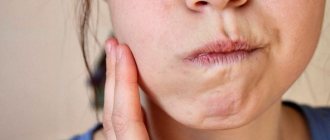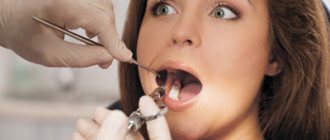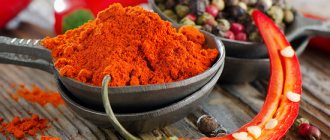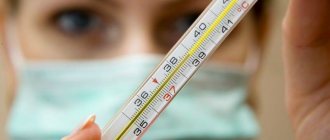After tooth extraction, especially if the procedure was complex, there is inflammation, swelling, suppuration in the mouth, you want to speed up the healing process of the wound and avoid complications from the appearance of pathogenic bacteria in it. To achieve this, surgeons often recommend mouth rinsing after surgery. But this does not always happen - sometimes the doctor will advise you not to do this.
Why is that? What is the correct way – when and with what to rinse your mouth after tooth extraction, and whether to rinse? We're talking to the doctors at the Family Smile dental clinic.
How gums heal after tooth extraction
It is worth knowing the specifics of the process in order to understand what is considered normal and what is not, and whether it is worth contacting the dentist again.
The average tissue recovery time is 10-15 days. During this period, the pain goes away, and new mucous gum tissue appears in place of the hole.
It all happens like this:
In the first two to three hours after the manipulation, the gums may bleed, and a thrombus will form in the socket - a blood clot that closes the wound from the penetration of bacteria. You shouldn’t injure him or try to spit him out.
Up to three days after the operation, the blood clot gradually thickens, decreases, and connective tissue begins to form inside the wound.
Three to seven days after the operation, the clot becomes lighter, and the hole is covered with young connective tissue. Pain and swelling go away.
After one to two weeks, bone tissue begins to form under the gum, in place of the extracted tooth.
After a couple of weeks, superficial healing is complete.
The timing may vary depending on the specific case and the patient’s health condition.
Do not ignore:
swelling, pain, bloody or other discharge from the socket that does not go away for more than 4 days.A “dry” socket is a deep cavity in the gum without a blood clot, but with a yellowish-gray, greenish, white coating and the smell of rotting.
Difficulty opening the mouth, clicking, pain in the temporomandibular joint that appeared after removal and did not go away within 2-3 days.
Numbness in parts of the gums and cheeks that did not go away after the anesthesia ended.
Runny nose, nasal congestion, and fever that appeared after removal.
In these cases, be sure to consult your doctor again.
Features of use during pregnancy and children
The drug can be used by patients of different age categories. It is absolutely safe for pregnant and nursing mothers, since it does not penetrate the mucous membrane or the upper layer of the epithelium. The active substance is not absorbed in the blood. Before using the drug, in order to prevent the manifestation of an allergic reaction, it is worth conducting a hypersensitivity test. To do this, apply a little solution to the skin in the wrist area and rub thoroughly. The body's reaction is assessed after 10–15 minutes. If there is no inflammation, redness, blisters, or rash, then Miramistin can be safely used.
The drug is indicated for children from 3 years of age. Taking the solution at an earlier age is possible only as prescribed by a doctor and under his supervision.
How to rinse your mouth after surgery
Ready-made pharmacy antiseptics and solutions made independently at home are applicable. Let's consider how to rinse your mouth after gum surgery or tooth extraction.
Your doctor may recommend not rinsing the wound on the day of surgery. Every other day, you can make oral baths with decoctions of chamomile, sage, or solutions of furatsilin, 0.05% chlorhexidine.
There are quite a few such drugs, and your doctor will give specific recommendations on what to rinse your mouth after gum or tooth removal. The choice of a suitable drug depends on the condition of the hole, the complexity of removal, the age of the patient, whether he has allergies or sensitivity to some components of the products.
Carefully! It is not recommended to use ethyl alcohol, hydrogen peroxide solution, brilliant green or iodine for rinsing. They can cause pain, burn the mucous membrane and lead to the detachment of a fresh clot.
Composition and release forms of the drug
"Miramistin" is a drug based on benzyldimethyl ammonium chloride. The concentration of the active component is 0.01%. The drug occupies a leading position among antiseptics and has a wide range of applications. Often used in dentistry. Its action is aimed at combating infections of a bacterial, fungal and viral nature. Miramistin also accelerates wound healing. By stimulating phagocytosis, it enhances the local immune response.
The drug is available in different forms. For rinsing, an aqueous or alcohol solution is used. It is transparent, practically odorless and tasteless.
How to rinse your mouth after tooth extraction
The main rule is not to rinse your mouth too vigorously. Immediately after tooth extraction, you should do oral baths rather than vigorous rinsing. Rinsing vigorously may cause the fresh clot to fall out of the socket. Bleeding will occur and healing will be delayed.
How to rinse your mouth with Chlorhexidine after tooth extraction? Let's use the example of this popular tool. First, rinse the mouth with warm boiled water to remove any remaining food. Then we put 15-20 ml of the drug into the mouth and hold it for 15-30 seconds. On the second or third day after removal, gentle rinsing movements are allowed. Spit and repeat 2-3 more times. The number of rinses during the day is 3-6.
How much to rinse your mouth after tooth extraction depends on how the healing is progressing. You can stop rinsing when young gum tissue has formed at the site of the hole.
Why is processing important?
Typically, a tooth is removed if it is so damaged that it cannot be restored. That is, both its visible part and the root are damaged, and at the same time it is not possible to install a reinforcing pin for subsequent prosthetic restoration with a crown. This procedure is possible only when the thickness of the root walls is at least 2 millimeters. If it has been severely damaged by caries, then the tooth has to be removed completely.
What is caries? This is rot, consisting of a mixture of bacteria. If even a small part of them gets into the wound left after tooth extraction, a purulent sac will certainly appear there. Moreover, all this can happen even without a pain symptom, because the dental nerve usually dies before this moment.
If the pus subsequently breaks out, it may result in blood poisoning. There are also cases where, due to bacterial infection of the wound after tooth extraction, the rotting process transferred to the jaw bone. As a result, part of it had to be removed.
And in order to prevent the above complications, the wound is treated with antiseptics and anti-inflammatory drugs. Miramistin solution (0.01%) is ideal for this, since it is active against bacteria, fungi, viruses, and at the same time strengthens local immunity and prevents the activation of the inflammatory process.
How to eat after tooth extraction
There is an opinion that it is better to fast for the first day after surgery and drink through a straw so that liquid does not get into the wound.
In fact, everything is not so: You can already eat 2-3 hours after the manipulation - the body needs strength to recover. For several days, you should include slightly warm, soft foods in your diet and avoid hard, spicy, too cold or hot foods. Optimal choice: puree soups, milk porridge, stew.
You can drink immediately after removing the cotton swab from your mouth. Contrary to popular recommendations, you should not drink through a straw - when you retract your cheeks, a vacuum effect is created, which can tear the clot from the wound.
The dentist will talk about the main points in oral care after surgery and answer questions after the procedure. Follow the recommendations so that you don’t encounter complications and healing goes quickly!
Contraindications and some features of the use of Miramistin
The drug is not used in case of hypersensitivity to benzyldimethyl ammonium chloride. Patients diagnosed with a catarrhal form of gastritis, which is provoked by an imbalance of the positive microflora of the gastrointestinal tract, should use the solution carefully. Miramistin enhances the effect of antibiotics. When using drugs together, it is necessary to adjust their dosages. The likelihood of adverse reactions occurring when taking the solution is very low.
The use of Miramistin for more than a week is not recommended, since it has an aggressive effect on the microflora of the oral cavity. Otherwise, the number of beneficial bacteria on the mucous membrane will decrease significantly. She will become vulnerable to various diseases. For example, stomatitis may develop.
With rinsing, the pain subsides on the second or third day. Bleeding should be minimal. The saliva may be slightly pink in the first two days. If you feel worse when rinsing, or local symptoms increase rather than go away, you should visit your doctor.
Clinical researches
According to the results of clinical trials of the ASEPTA® rinse After 3 weeks of using the ASEPTA® rinse, gum bleeding is reduced by 28.3%, inflammation is reduced by 32.3% and the hygienic condition of the oral cavity is improved by 33.5%.
The mouthwash is designed to protect gums from inflammation and improve oral hygiene and is recommended for use by patients suffering from:
- acute and chronic gingivitis;
- acute and chronic periodontitis;
- stomatitis;
- post-extraction alveolitis;
- toothache of infectious origin.
Sources:
- The role of anti-inflammatory rinse in the treatment of periodontal diseases (L.Yu. Orekhova, A.A. Leontyev, S.B. Ulitovsky) L.Yu. OREKHOVA, Doctor of Medical Sciences, Prof., Head of Department; A.A. LEONTIEV, dentist; S.B. ULITOVSKY, Doctor of Medical Sciences, Prof. Department of Therapeutic Dentistry of St. Petersburg State Medical University named after. acad. I. P. Pavlova
- Report on clinical trials to determine/confirm the preventive properties of commercially produced personal oral hygiene products: mouth rinse "ASEPTA PARODONTAL" - Solution for irrigator." Doctor of Medical Sciences Professor, Honored Doctor of the Russian Federation, Head. Department of Preventive Dentistry S.B. Ulitovsky, doctor-researcher A.A. Leontiev First St. Petersburg State Medical University named after academician I.P. Pavlova, Department of Preventive Dentistry.
- Report on determining/confirming the preventive properties of commercially produced personal oral hygiene products: Asepta toothpaste used in combination with Asepta mouthwash and Asepta gum balm Head. Department of PFS Doctor of Medical Sciences Professor S.B. Ulitovsky St. Petersburg State Medical University named after Academician I.P. Pavlova. Faculty of Dentistry. Department of Preventive Dentistry.
Is it possible to brush your teeth
Oral hygiene must be observed. But there are a few points worth paying attention to:
- Do not touch the hole with the brush,
- reduce the amount of paste,
- rinse your mouth very carefully and slowly.
And one more thing: never take medications without a doctor’s prescription. In simple cases, medications will not be needed, at most a light pain reliever. In difficult cases, the dentist will prescribe an antibiotic and an antihistamine.
Using these recommendations, you will survive tooth extraction easily and unnoticed. If you have any other questions, call ART Dent dentistry, our specialists will definitely help you.
What and when to eat
You can't eat or drink for the first three hours. First, during anesthesia, you can bite your cheek or tongue. Secondly, the blood clot must harden in the hole.
After this, you can eat, but you should avoid hot, cold, spicy and rough foods. You should absolutely not drink hot drinks: they will not only increase blood flow, but can also dissolve the protective clot.
If the removal was difficult, the dentist will recommend a diet of soft and liquid foods for a day or two.
Chew food with the teeth located on the non-operated side.
Dangerous influence
Thirty-two teeth is not a marketing ploy, but a normal number in the oral cavity. Some people are lucky and all their wisdom teeth erupt through the gums, as expected, by the age of 24, without discomfort, in the right direction.
Additional information: if necessary, the orthodontist decides to remove unerupted eights in adolescents with malocclusion or severely crooked teeth in order to avoid serious oral surgery in the future.
But more often they cause a number of inconveniences to the owner:
- eruption direction;
- cheek injury;
- inflammation of the gums through which teething occurs.
In these cases, the patient experiences discomfort, pain and even swelling. At the same time, only a few are decided to be deleted.
Dangers of using chlorhexidine mouthwash
You should not uncontrollably use chlorhexidine solution to rinse your gums and teeth; this can lead to a number of problems.
- Chlorhexidine affects not only pathogens, but also the natural flora of the oral cavity, which can ultimately lead to imbalances in the microflora. Uncontrolled use of an antiseptic has an effect on both good microbes and bad ones, but after stopping use, the bad microbes grow faster than the good ones.
- Constant use of an antiseptic can cause microflora resistance. According to recent studies, chlorhexidine causes resistance to antibiotics when they are really needed.
- Due to regular use of chlorhexidine for rinsing, intense dark plaque may appear on the teeth and tongue. This problem will have to be solved in the dentist's chair. This solution should be used only after consultation with a doctor and only for a limited period. This also applies to various toothpastes and rinses that contain it.
Book an appointment with a periodontist now by clicking the “Plus” button on the right side of your screen.
To the list of posts
What to do with pain
The main fear before tooth extraction is pain. In fact, the operation is painless, because... takes place under anesthesia, which will remain in effect for another two hours after the procedure. Then the pain will begin to increase. Any painkiller already familiar to you or prescribed by a doctor will help eliminate them.
Most often, doctors advise Ketanov, Ketorol or the most common Nurofen. Mild discomfort continues for a couple of days.
With proper tooth extraction, the pain should not intensify, but if this happens, you should definitely consult a doctor.
Pathology and norm
With any invasive procedure, swelling occurs in the soft tissues. It goes away on its own within a few days. The same can be said about pain. Cheekbones, adjacent teeth, head, and neck may hurt. If after 3 or 4 days the symptoms do not disappear, but increase, then this indicates pathology.
What are the complications after tooth extraction:
- alveolitis, osteomyelitis, most often occurring with dry socket;
- inflammation near the seams;
- damage to the adjacent dental unit;
- perforation of the bottom of the maxillary sinus, if extraction is performed on the upper jaw;
- fracture of the alveolar process, sharp edges of the alveolus that injure soft tissues;
- neuritis of the inferior alveolar nerve;
- postoperative cyst;
- paresthesia, which is characterized by numbness, loss of sensitivity of the cheeks, tongue, jaw and other adjacent areas;
- ondogenic phlegmon, periostitis;
- a hematoma in the neck can occur in people suffering from arterial hypertension (blood leaks out of the vessels into the tissue);
- soft tissue abscesses.
Pus and flux after tooth extraction characterize an acute inflammatory process that requires urgent treatment. Purulent inflammation can occur with insufficient antiseptics during surgery or poor postoperative care, with a dry socket, when food particles get into the hole. A new surgical operation is required to remove necrotic masses.
When to see a doctor:
- on the second and third days the swelling does not subside, but the cheek continues to swell;
- the pain becomes more intense and is difficult to eliminate with medications;
- the high temperature lasts for several days, normally it should decrease within 24 hours;
- no appetite, nausea, weakness;
- when pressing on the gum, pus is released, and its edges turn red;
- when palpating the hole with the tongue, no blood clot is detected.
If inflammatory processes are started, this can lead to the melting of bone tissue, an abscess and the spread of infection.



